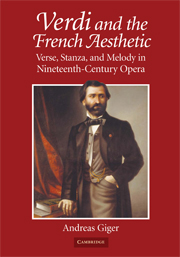Book contents
- Frontmatter
- Contents
- Acknowledgments
- Introduction
- Part I VERSIFICATION AND MELODIC AESTHETICS
- 1 Rhythm and stanza in French and Italian librettos
- 2 French and Italian melodic aesthetics and practice ca. 1830–1870
- Episode: Design, middleground rhythm, and phrase
- Part II FRENCH MELODY IN VERDI'S OPERAS
- Appendix: Principal theoretical texts cited (arranged in chronological order by date of publication)
- Notes
- Bibliography
- Index
1 - Rhythm and stanza in French and Italian librettos
Published online by Cambridge University Press: 22 September 2009
- Frontmatter
- Contents
- Acknowledgments
- Introduction
- Part I VERSIFICATION AND MELODIC AESTHETICS
- 1 Rhythm and stanza in French and Italian librettos
- 2 French and Italian melodic aesthetics and practice ca. 1830–1870
- Episode: Design, middleground rhythm, and phrase
- Part II FRENCH MELODY IN VERDI'S OPERAS
- Appendix: Principal theoretical texts cited (arranged in chronological order by date of publication)
- Notes
- Bibliography
- Index
Summary
French versification
The French have long taken great pride in the verse forms of their lyric, epic, and dramatic literature. Opera librettos form an important subclass of this corpus, so it is somewhat surprising that comprehensive theoretical works analyzing French verse largely exclude operatic texts. Several reasons may account for this exclusion.
First, librettos are not generally considered to be autonomous works but rather texts subservient to music. Throughout most of the nineteenth century, French librettos were written entirely in verse but at the same time had to provide enough variety of poetic meter, accentual pattern, and stanzaic structure to accommodate the musical style envisioned by the composer. In recitatives, the meters were generally longer and changed more frequently, whereas in arias, they tended to be shorter, more uniform, and more regularly accented to allow for regular rhythms and phrases.
Second, librettos followed neither French drama in maintaining a uniform meter throughout an entire work nor lyric poetry in relying exclusively on stanzas. Thus, the mixture of stanzaic, non-stanzaic, and hybrid forms, as well as the greater freedom librettists took with traditional rules, seem to have caused theorists to regard the French libretto as an unsuitable genre for illustrating the principles of versification, even though many parts of these librettos would have been sufficiently traditional to illustrate particular points. Moreover, there is in fact no single “theory” of French versification. The treatises reflect a wide variety of approaches, some more or less compatible with each other, others contradictory.
- Type
- Chapter
- Information
- Verdi and the French AestheticVerse, Stanza, and Melody in Nineteenth-Century Opera, pp. 7 - 42Publisher: Cambridge University PressPrint publication year: 2008

